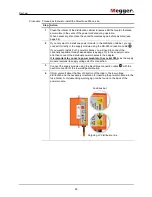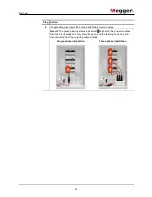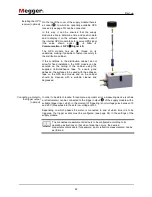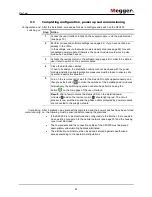
Controlling and monitoring in running operation
42
5.2.2
Fault location in pulse mode (optional „fault location“
function required)
If repeated failures/shutdowns indicate a cable fault, the SFC250 provides a number of
options for localizing the fault without having to disconnect the consumer from the grid.
In some cases, the fault distance determined by the location algorithm (see page 37)
may already provide sufficiently accurate conclusions about the fault location. A
measuring device that is connected in parallel to the line and triggered by the supply
module can also be used for exact fault location. Assuming that the fault reliably ignites
shortly after switching on the fuse, the position can be tracked down to the meter with
the aid of a suitable ground microphone (for example, di) or the fault sniffer
system. For this purpose, the SFC250 has a pulse mode, in which the power switch is
switched on repeatedly for a defined number of half-cycles, and in each case an ignition
of the fault is forced.
Pulse mode must be enabled before the start of pinpointing using the
Settings
Fault location
Pulse mode
menu (also accessible by clicking
Pulse mode
in the
main screen) and configured as desired.
Parameter
Description
PM-A | PM-B | PM-C
Activate/deactivate pulse mode for the connected power modules
individually.
Pulse mode can only be enabled, if the power switch is off
.
auto. / man.
Selection between automatic and manual pulse mode.
In the setting
man.
, when the
button is pressed in the main
menu or with the
button on the remote control, exactly one
pulse is triggered.
In the setting
auto.
, after pressing the
button in the main
menu or with the
button on the remote control, periodic
pulses are automatically generated. The interval of the pulse
sequence can be set under
Pause (sec.)
.
Pause (sec.)
Interval of automatic pulse sequence in pulse mode.
Half-waves
After each reclosure, the power switch will remain on for the
number of halfwaves defined here, unless a short circuit or fault
current causes a shutdown beforehand.
If changes have been made, they must be saved via the
button.
If pulse mode has been activated for at least one of the connected power
modules, the button
in the software and the button
on the remote control
are only used to control the pulse operation (see next page). Power modules that
are not in pulse mode are switched on with the first actuation (if the switch was
not already been closed), but thereafter no longer respond to further actuations of
the button/key. This behavior only changes again once pulse mode has been
deactivated for all power modules.
Activating/deactivating
and configuring pulse
mode
















































